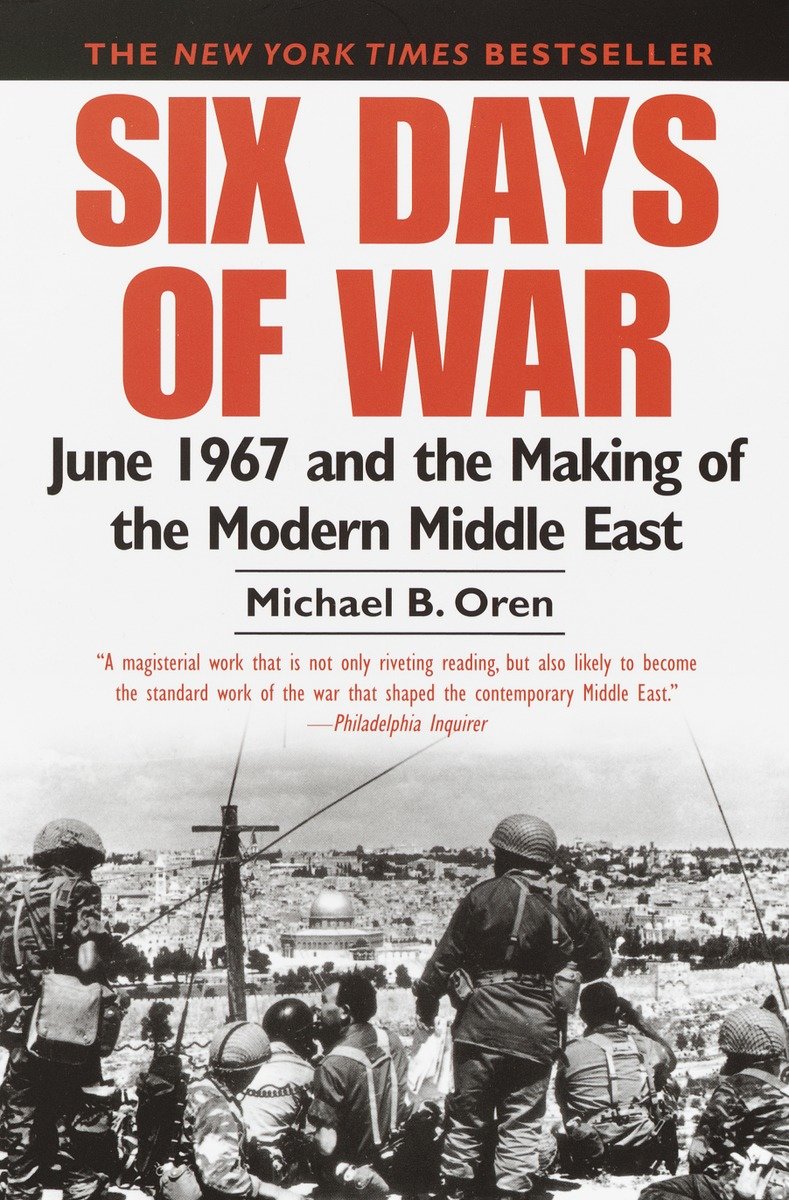June 1967 and the Making of the Modern Middle East: Six Days of War
16.00 JOD
Please allow 2 – 5 weeks for delivery of this item
Description
NEW YORK TIMES BESTSELLER • The first comprehensive account of the epoch-making Six-Day War, from the author of Ally—now featuring a fiftieth-anniversary retrospective Though it lasted for only six tense days in June, the 1967 Arab-Israeli war never really ended. Every crisis that has ripped through this region in the ensuing decades, from the Yom Kippur War of 1973 to the ongoing intifada, is a direct consequence of those six days of fighting. Writing with a novelist’s command of narrative and a historian’s grasp of fact and motive, Michael B. Oren reconstructs both the lightning-fast action on the battlefields and the political shocks that electrified the world. Extraordinary personalities—Moshe Dayan and Gamal Abdul Nasser, Lyndon Johnson and Alexei Kosygin—rose and toppled from power as a result of this war; borders were redrawn; daring strategies brilliantly succeeded or disastrously failed in a matter of hours. And the balance of power changed—in the Middle East and in the world. A towering work of history and an enthralling human narrative, Six Days of War is the most important book on the Middle East conflict to appear in a generation.Praise for Six Days of War“Powerful . . . A highly readable, even gripping account of the 1967 conflict . . . [Oren] has woven a seamless narrative out of a staggering variety of diplomatic and military strands.”—The New York Times “With a remarkably assured style, Oren elucidates nearly every aspect of the conflict. . . . Oren’s [book] will remain the authoritative chronicle of the war. His achievement as a writer and a historian is awesome.”—The Atlantic Monthly “This is not only the best book so far written on the six-day war, it is likely to remain the best.”—The Washington Post Book World “Phenomenal . . . breathtaking history . . . a profoundly talented writer. . . . This book is not only one of the best books on this critical episode in Middle East history; it’s one of the best-written books I’ve read this year, in any genre.”—The Jerusalem Post “[In] Michael Oren’s richly detailed and lucid account, the familiar story is thrilling once again. . . . What makes this book important is the breadth and depth of the research.”—The New York Times Book Review “A first-rate new account of the conflict.”—The Washington Post “The definitive history of the Six-Day War . . . [Oren’s] narrative is precise but written with great literary flair. In no one else’s study is there more understanding or more surprise.”—Martin Peretz, Publisher, The New Republic “Compelling, perhaps even vital, reading.”—San Jose Mercury News
Additional information
| Weight | 0.49 kg |
|---|---|
| Dimensions | 2.8 × 15.5 × 23.12 cm |
| PubliCanadation City/Country | USA |
| by | |
| Format | Paperback |
| Language | |
| Pages | 496 |
| Publisher | |
| Year Published | 2003-6-3 |
| Imprint | |
| ISBN 10 | 0345461924 |
| About The Author | Michael B. Oren is an American-born Israeli historian and author, and was Israel’s ambassador to the United States from 2009 to 2013. He has written three New York Times bestsellers—Ally: My Journey Across the American-Israeli Divide; Power, Faith, and Fantasy: America in the Middle East, 1776 to the Present; and Six Days of War: June 1967 and the Making of the Modern Middle East, which won the Los Angeles Times Book Prize for history and the National Jewish Book Award. Throughout his illustrious career as a Middle East scholar, Dr. Oren has been a distinguished fellow at the Shalem Center in Jerusalem, a contributing editor to The New Republic, and a visiting professor at Harvard, Yale, and Georgetown. The Forward named Oren one of the five most influential American Jews, and The Jerusalem Post listed him as one of the world’s ten most influential Jews. He currently lives with his family in Tel Aviv. He is a member of the Knesset and the Deputy Minister for Diplomacy in the Prime Minister's Office. |
“Powerful . . . A highly readable, even gripping account of the 1967 conflict . . . [Oren] has woven a seamless narrative out of a staggering variety of diplomatic and military strands.”—The New York Times “With a remarkably assured style, Oren elucidates nearly every aspect of the conflict. . . . Oren’s [book] will remain the authoritative chronicle of the war. His achievement as a writer and a historian is awesome.”—The Atlantic Monthly “This is not only the best book so far written on the six-day war, it is likely to remain the best.”—The Washington Post Book World “Phenomenal . . . breathtaking history . . . a profoundly talented writer. . . . This book is not only one of the best books on this critical episode in Middle East history; it’s one of the best-written books I’ve read this year, in any genre.”—The Jerusalem Post “[In] Michael Oren’s richly detailed and lucid account, the familiar story is thrilling once again. . . . What makes this book important is the breadth and depth of the research.”—The New York Times Book Review “A first-rate new account of the conflict.”—The Washington Post “The definitive history of the Six-Day War . . . [Oren’s] narrative is precise but written with great literary flair. In no one else’s study is there more understanding or more surprise.”—Martin Peretz, Publisher, The New Republic “Compelling, perhaps even vital, reading.”—San Jose Mercury News |
|
| Excerpt From Book | AfterwoodMORE THAN TWO YEARS HAVE PASSED since the outbreak of the latest Middle Eastern turmoil, and there is still no cease-fire in sight. Called by Palestinians the al-Aqsa Intifada, and by the Israelis the “disturbances,” the “events,” or, simply, the Palestinian terror, the violence that erupted in September 2000, and which has raged ever since, is in every sense a war. No less than in 1948 and 1967, Arabs and Israelis are today once again battling over the final disposition of the area known in Arabic as Filastin and in Hebrew as Eretz Yisrael—the Land of Israel. As in the processes leading up to previous Arab-Israeli confrontations, mounting violence between Palestinians and Israelis threatens to set the entire region ablaze.In many respects, the current fighting resembles the civil war in Palestinethat broke out in November 1947, following the UN’s decision to partition thecountry into independent Jewish and Arab states. The Zionist leadership acceptedthe notion of territorial compromise, but the Arabs of Palestine saw noreason to forfeit what they considered their exclusive national rights, and determinedto block the partition with attacks against Jewish settlements, roadsystems, and neighborhoods. Other Arab forces, most prominently those associatedwith the militant Muslim Brotherhood, aided the Palestinian Arabs fromacross the border. The Jews, for their part, initially showed restraint, but inApril 1948, fearing annihilation, they too went to war. Subsequently, dozens ofArab villages and towns were destroyed, their populations displaced, and theirleaders either killed or rendered ineffective. But the Palestinians’ defeat generatedsympathy throughout the Arab world and intensified the pressure on Arableaders to intervene against the Jews. The result came one month later with theadvent of the first Arab-Israeli war.A remarkably similar process occurred more than fifty years later, in thelatter half of 2000, when the Clinton Administration again proposed to partitionthe land between the Palestinians and the Jews. Specifically, the UnitedStates called for the creation of a Palestinian state in virtually all of the WestBank and the entire Gaza Strip—Israeli settlements would either be removedor concentrated in blocks—with its capital in East Jerusalem. A small numberof Palestinian refugees would be repatriated to Israel; the rest were to receivecompensation. The Palestinian state would live side by side with Israel in relationsof full peace, but while Israeli prime minister Ehud Barak approved theformula, the Palestinian Authority under its president, Yasser Arafat, rejectedit. Rather, Arafat demanded the return of all the refugees—a move that, if implemented,would have created a Palestinian majority in Israel. As in 1947–48, theissue was not merely the borders of the Jewish state, but its very existence.The Palestinians consequently embarked on an armed offensive using tacticsreminiscent of those employed in 1947–48—roadside ambushes, snipers,and car bombs—together with the innovation of suicide bombers. Militant Islamicelements once more played a prominent role in the campaign. At first,Israel’s reaction was again restrained, but as casualties rapidly mounted, theIDF finally struck back. In April 2002, Israeli forces reoccupied much of theWest Bank, causing extensive damage to Palestinian cities and villages, andkilling or isolating many Palestinian leaders. As in 1948, the Palestinians’ plightaroused sympathy in neighboring Arab countries and placed pressure on theirleaders to intercede. Soon Hezbollah guerrillas in Lebanon were launchingrockets into northern Israel; the Syrian army went on high alert, as did units inJordan, Egypt, and Iraq. Israel mobilized its reserves. The region careered towardyet another Arab-Israeli war.The fighting in 2000–2002 recalled not only the events of 1947–48 but,even more poignantly, those of 1967. That war, this book asserts, was the resultof a series of incidents triggered by Palestinian guerrilla raids and Israel’sretaliations against them. Today, more than three decades later, the MiddleEast is still in the grips of a context of conflict in which a single spark can ignitea regional conflagration. Such a spark was kindled in September 2000, whenAriel Sharon, then head of Israel’s parliamentary opposition, paid a visit to theHaram al-Sharif, or Temple Mount, in Jerusalem.Though the visit had been cleared with the Palestinian Authority, manyPalestinians viewed it as a provocation and protested against it violently. Firingon the rioters, Israeli forces provided the pretext for launching an intifada, orpopular uprising, named after the Haram’s al-Aqsa mosque. Mass demonstrationsof Palestinian youths soon escalated into armed attacks against Israelitargets, most of them civilian, and increasingly fierce countermeasures by Israel.Israeli reprisals in turn instigated unrest in adjacent Arab countries. The “street” was once again agitating—a déjà vu of 1967—and Arab rulers had littlechoice but to act.Unlike in 1948 and 1967, however, war between Arabs and Israelis did noterupt in 2002. Though the region has remained in many ways unchanged, severalfundamental transformations nevertheless have combined to mitigate thedangers of war.There is, firstly, the existence of peace treaties between Israel and Egypt andIsrael and Jordan. In spite of their failure to bring about any true reconciliationbetween their signatories, these agreements have nonetheless provided the nationswith open channels of communication and venues for reducing tensions.Another change is the emergence of the U.S.-Israeli alliance that not only guaranteesIsrael a decisive military edge over its enemies, but also affords Washingtonfar-reaching influence over Israeli actions. Finally, there is the nonconventionalweaponry now in the arsenals of virtually every Middle Eastern state, which hassharply elevated the stakes in any Arab-Israeli confrontation.Yet for every change curtailing the chances of war, another could equallycontribute to its outbreak. Absent today is the peculiar stability engendered bythe Cold War, of a rational counterpart whom the U.S. president might hotlinein a crisis, and superpower constraints over key regional players such as Iraq,Iran, and Syria. The once neat division between Arab radicals and Arab conservativeshas been replaced by internal fissures within each Arab country—betweeneach regime and its domestic, often Islamic, opposition—and even thelines in the Arab-Israeli conflict have become obscured. Most destabilizing,arguably, is the growth of terrorist organizations, global in outlook and adamantin their theology, transcending all borders and contemptuous of any attemptto restrain them.These countervailing changes, coupled with the continuing friction surroundingnondemocratic Middle Eastern regimes and Arab resistance to thevery idea of a Jewish state, might have set the stage for an Arab-Israeli warbigger and possibly more destructive than those of 1948 and 1967. Instead, warin 2002 was averted by the timely intervention of the United States. As tensionsin the region spiraled toward an explosion, President George W. Bushstrongly advised Syria to rein in its Hezbollah allies and told the PalestinianAuthority that its support of terror was totally unacceptable to Americans. Atthe same time, Washington publicly recognized Israel’s right to defend itselfand convinced Israelis that they did not stand alone. Bush’s actions—admonishingthe Arabs and reassuring the Israelis—were precisely those that LyndonB. Johnson failed to take in 1967, and in 2002 they succeeded in containing, ifnot defusing, the crisis.Like Johnson, Bush was engaged in an international struggle with an implacableenemy—no longer communism, of course, but Islamic extremism—but rather than tie his hands as Vietnam once had Johnson’s, America’s newconflict impelled George Bush to act. The events of September 11, 2001, spurreda radical departure from long-standing American policies toward the Middle East.Having become the victim of large-scale Arab terror, the administration voicednewfound empathy for Israel and its struggle against suicide bombers and gunmen,and went so far as to identify Israel’s enemies—Hamas and Islamic Jihad—as America’s. Moreover, in declaring war against international terrorism, indispatching its soldiers thousands of miles to fight in Afghanistan and, avowedly,in Iraq, Washington could hardly deny Israel the ability to strike back inthe West Bank and Gaza, its own backyard. Concomitantly, American leadersexpressed severe reservations regarding the Arab states, even toward their traditionalallies, Egypt and Saudi Arabia, citizens of which were heavily implicatedin 9/11. Relations between the U.S. and the Arab world were furtherstrained by the Arabs’ reluctance to support a military effort to invade Iraq andoust its dictator, Saddam Hussein.The success of Bush’s effort to rally an anti-Saddam coalition is not, as ofthis writing, guaranteed. Numerous obstacles, domestic and foreign, stand inthe president’s way. Nor is it certain whether the toppling of Saddam will installdemocracy or merely another dictatorship in Iraq, or whether war in thegulf will ultimately enhance or further impair the area’s stability. One fact,alone, is incontestable: that the Middle East remains a flash point of multilateralconfrontation, a source of seemingly intractable controversies, and a powderkeg that the slightest spark could ignite. A context of conflict continues toseize the region, demanding of its leaders almost constant displays of both courageand caution.November 2002 |
Only logged in customers who have purchased this product may leave a review.






Reviews
There are no reviews yet.